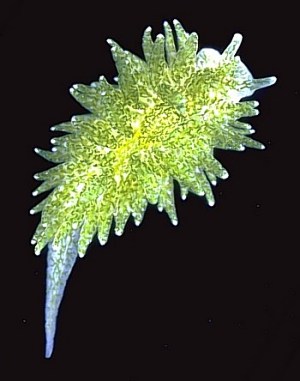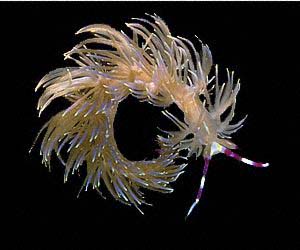

Solar-powered sea slugs
PHOTO
UPPER: The sacoglossan Placida cf. dendritica showing the green network of ducts which contain the green chloroplasts from its algal food.
LOWER: The aeolid nudibranch Pteraeolidia ianthina which "farms" colonies of brown single-celled algae (zooxanthellae) in its body.
PHOTOS: Bill Rudman.
Two quite different groups of sea slugs have evolved ways of using the ability of plants to convert the sun's energy into sugars and other nutrients. In simple terms they have become "solar powered".
The herbivorous sacoglossans are suctorial feeders removing the cell sap from the algae on which they feed. In most, the cell contents are simply digested by the slug. Some species however have evolved branches of their gut which ramify throughout the body wall and contain plastids, which are the photosynthesising "factories" from the algae, alive and operating. In many cases these plastids are chloroplasts, but sacoglossans that feed on red and brown algae are also reported to keep the plastids from these algae alive as well. As I show elsewhere in the Forum, one species, Elysia cf furvacauda changes diet and plastid at least three times during its life history.
In nudibranchs, which are all carnivorous, many have evolved similar ways of keeping whole single-celled plants (zooxanthellae) alive in their bodies. In most cases the zoxanthellae are obtained from their food, often cnidarians, which already have symbiotic zooxanthellae in their bodies. This symbiosis as evolved many times within the nudibranchs with examples in many quite unrelated families and orders. Have a look at the following species for further information: Pteraeolidia ianthina, Phyllodesmium longicirrum, Phyllodesmium briareum, Phyllodesmium crypticum, Berghia verrucicornis, Spurilla australis, Pinufius rebus - zooxanthellae symbiosis, A. ransoni,A. harrietae, Melibe megaceras, Elysia cf. furvacauda, Elysia cf. pilosa, Plakobranchus ocellatus, Elysia crispata, Elysia chlorotica.
For further information:
• Zooxanthellae Symbiosis References.
•Zooxanthellae - what are they?
•Zooxanthellae - in Cnidarians
•Zooxanthellae - in nudibranchs
• Chloroplast Symbiosis References.
• Aspects of Coral feeding
• Chloroplast symbiosis Research
• Sacoglossan Feeding
• Feeding on Palythoa
Rudman, W.B., 1998 (October 11) Solar-powered sea slugs. [In] Sea Slug Forum. Australian Museum, Sydney. Available from http://www.seaslugforum.net/factsheet/solarpow
Related messages
-
Tank/Phototaxis/Energy/Experiments
From: Mihir Pathak, October 8, 2008 -
Solar-powered Sea Slugs - tertiary endosymbiosis?
From: Sam Hsieh, October 28, 2002 -
'Solar-powered' sea slugs
From: Caroline R. Cripe, September 4, 2001 -
sea slugs - plants or animals?
From: Tom Mackillop, March 23, 2001 -
Elysia and chloroplast symbiosis
From: Daniel Barshis , August 4, 2000 -
Review of sacoglossan - plastid symbiosis
From: Liz Summer, May 17, 2000 -
Symbiosis among Phyllidia?
From: Mark Schoenbeck, January 8, 2000 -
The solar-powered 'Ruffled Sea Slug'
From: Molly E. Hagan, December 5, 1999 -
Sea Slugs & symbiotic algae
From: Jennifer Whittington, August 16, 1999 -
Information on solar animals?
From: Derek Carmona, March 10, 1999 -
Solar-powered sacoglossans in Norway?
From: Jussi Evertsen, March 9, 1999 -
Photosynthetic Animals
From: Michael Rhodin, December 16, 1998 -
"Solar-powered" Sea Slugs
From: Tammy, November 29, 1998 -
Nudibranchs in Symbiosis with Zooxanthellae
From: J.E. Austin, November 9, 1998 -
Your "solar-powered" sea slugs.
From: Amanda Lindsey, October 11, 1998 -
Zooxanthellae in nudibranchs
From: J.E.Austin, October 11, 1998
